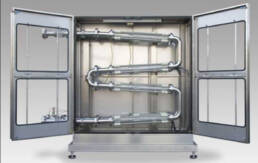

APPLICATIONS
Our ohmic heating process is used in food industry for over 20 years. Emmepiemme is highly specialized and offers various types of installations and technical solutions to ensure a reliable and efficient process.
Various types of ohmic heaters have been developed over the past two decades, using new materials and advanced technology solutions, it was possible to build plants for heating treatments, pasteurization, sterilization, HTST (high temperature short time) for various categories of products, including:
- Fruit puree (peach, pear, strawberry)
- Fruit pieces (peach, pear, strawberry, pineapple, apricot)
- Vegetable cream
- Whole or pieces of vegetables
- Spreads and stringy paste cheese
- Egg products
- Dairy cream
- Algae
- Creamy and vegetable sauces
- Minestrone
- Jam
- Syrup
FUTURES
Due to the above reasons, the ohmic heater can process, uniformly and in short times (from 10 to 90 sec), both homogeneous and heterogeneous products. For the latter some precautions must be taken as regards the composition of the carrying fluid, which electrical properties should be similar to the ones of the solid particles.
Ohmic processing approaches to some extent the HTST (High Temperature Short Time) concept, therefore the thermal damage of the product is remarkably reduced in comparison to conventional heating methods.
Sensory parameters in particular, like color, consistence and flavor are very satisfactory compared with the incoming fresh material.
Apart from the reported quality improvements, the industrial applications of Emmepiemme ohmic heater pointed out some further benefits in comparison with conventional heating methods, which are mentioned below.
- Flexibility
- Elasticity
- Modular construction
- Compactness
- Large-section pipes
- Commercial advantages
EURIMAQ es distribuidor autorizado de EMMEPIEMME

OHMIC HEATER
OVERVIEW
An ohmic heater also known as a joule heater is an electrical heating device that uses the electrical resistance of the liquids to generate heat, that is produced directly within the fluid itself by Joule effect, as alternated electric current passes through a conductive material. This has the result of transform energy causing a temperature rise. The most commonly used heating techniques for liquids rely on heat transfer from a hot surface. This heat can be generated directly from an electrical heating element or indirectly from a hot means of transportation (e.g. steam) via a heat exchanger (e.g. shell and tube ,plate). These methods require a temperature gradient to transfer the heat to the process liquid, therefore, the surfaces are at a higher temperature than the product.
emmepiemme ohmic applicator
This can cause fouling of the surfaces for certain products which become burnt on to the hot surfaces, reducing heat transfer rates and adversely affecting the product. A further issue with heat transfer is found when heating very viscous fluid and fluids with particulates, where a uniform heat transfer is difficult to achieve. Ohmic heaters address the aforementioned problems by removing hot surfaces from the heating of the fluids.